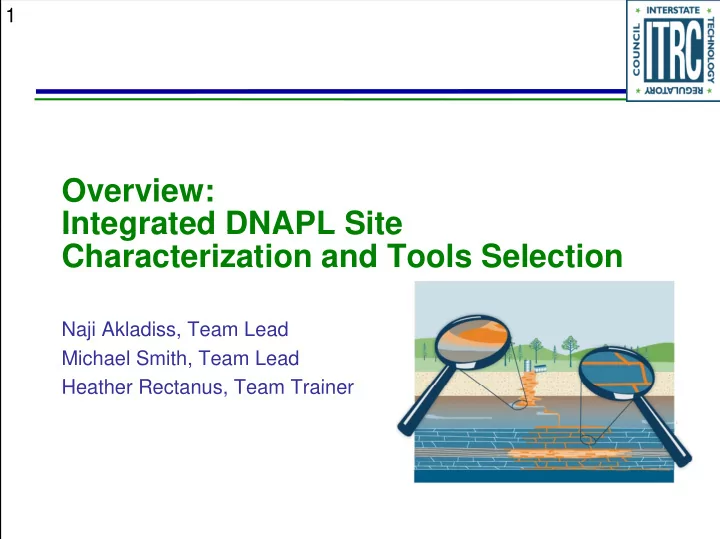

1 Overview: Integrated DNAPL Site Integrated DNAPL Site Characterization and Tools Selection Naji Akladiss, Team Lead Michael Smith, Team Lead Heather Rectanus Team Trainer Heather Rectanus, Team Trainer
2 The Problem: Dense Non-Aqueous Phase Liquid (DNAPL) Sites q ( ) Not achieving cleanup goals Spending time and money, but substantial risk remains Common site challenges • Incomplete understanding of DNAPL it DNAPL sites • Complex matrix – manmade and natural and natural • Unrealistic remedial objectives Coal Tar • Selected remedy is not satisfactory
3 The Problem: Outdated DNAPL Site Characterization Concepts p Considered contaminant flow was similar to groundwater flow groundwater flow Simplifying assumptions in equations based on Darcy flow led to inadequate characterization of Darcy flow led to inadequate characterization of • Site geologic heterogeneity 1980’s view • Contaminant Distribution Characteristics Receptor Re Behavior Behavior eceptor This approach limited Plume success of site remediation success o s e e ed a o activities
4 The Solution: An Integrated DNAPL Site Strategy gy ITRC Technical and Regulatory Guidance Document: Integrated Guidance Document: Integrated DNAPL Site Strategy (IDSS-1, 2011) Comprehensive site management Use at any point in site lifecycle Key topics y p • Conceptual site model (CSM) • Remedial objectives • Remedial approach • Remedial approach • Monitoring approach • Evaluating your remedy Associated Internet-based training ITRC IDSS-1, Figure 1-2
5 Adding to the Solution: Integrated DNAPL Site Characterization ITRC Technical and Regulatory Guidance Document: Integrated g DNAPL Site Characterization (ISC-1, 2015) Benefits More accurate conceptual site models (CSMs) ( ) Improved predictability of plume behavior and risks More defensible knowledge of More defensible knowledge of contaminant distribution Facilitates communication Reduced uncertainty Reduced uncertainty Better performing remedies ITRC ISC-1, Figure 4-1
6 Incorporated into the Solution: New DNAPL Site Characterization Approaches Heterogeneity replaces homogeneity Anisotropy replaces isotropy Diffusion replaces dispersion Diff i l di i Back-diffusion is a significant source of contamination and plume growth contamination and plume growth Non-Gaussian distribution Transient replaces steady-state conditions Transient replaces steady-state conditions Nonlinear replaces linear sorption Non-ideal sorption replaces ideal sorption Non ideal sorption replaces ideal sorption
7 Guidance Overview DNAPL Characteristics Life Cycle of a DNAPL Site Integrated Site Characterization Tool Matrix Summary ISC-1, Chapter 2
8 DNAPLs – Not Just Chlorinated Solvents! “Neat” PCE in Soil Core Mixed Aged Motor Oil/Bunker, Aryl Phosphate and PCB in Soil Core Coal Tar
9 Important DNAPL Properties Affecting Mobility y Density Solubility Viscosity Viscosity Volatility Volatility Composition Sorption Modified from ISC-1, Chapter 2
10 DNAPL Interactions with the Sub- Surface Media Affecting Mobility g y Modified from ISC-1, Chapter 2
11 Guidance Overview DNAPL Characteristics Life Cycle of a DNAPL Site Integrated Site Characterization Tool Matrix Summary ISC-1, Chapter 3
12 Controlling Role of Geology in Matrix Diffusion Figure courtesy of Fred Payne, Arcadis
13 Redefining the DNAPL Source Term: Apparent Secondary Sources • DNAPL Source Areas Areas impacted by impacted by • Unsaturated (Vadose) U t t d (V d ) DNAPL Zone • DNAPL may have dissolved Secondary or the DNAPL may be Sources remediated Molecular Sorption/ diffusion into desorption to p low k zones aquifer matrix • Slow Desorption from • Matrix Diffusion from sources within plume sources within plume aquifer solids aquifer solids Modified from ISC-1, Chapter 2
14 Diffusion Replaces Dispersion in Dissolved Phase Plumes As the length scale of interest decreases Diffusion replaces Dispersion in plume behavior replaces Dispersion in plume behavior Geologic heterogeneity and anisotropy also lead to numerous small plumes within each groundwater plume p g p Figures courtesy of Fred Payne, Arcadis
15 Heterogeneity Replaces Homogeneity Simplifying the Borden Tracer Simulation – Combined subsurface as subsurface as Heterogeneity and Diffusivity Effects homogeneous & isotropic has not 3 3 worked well for k d ll f epth (m) remediation-scale plume geometry De Anisotropy replaces isotropy 0 0 N Non-ideal behavior is id l b h i i 0 5 10 as pronounced in the Distance (m) vertical Figure courtesy of Fred Payne, Arcadis
16 Guidance Overview DNAPL Characteristics Life Cycle of a DNAPL Site Integrated Site Characterization Tool Matrix Summary
17 Integrated Site Characterization Flexible, iterative 8-step Flexible, iterative 8 step process for CSM refinement
18 Integrated Site Characterization Plan characterization (1-4) Plan characterization (1 4) 1. Define the problem 2. Identify data needs and resolution 3. Develop data collection objectives objectives 4. Design data collection and analysis plan
19 Data Quality Objectives are “Built in” Q y j USEPA Data Quality Objectives Step 1: State Problem Step 2: Identity Goal of Study Step 2: Identity Goal of Study Step 3: Identify Information Inputs Step 4: Define Boundaries of Study Step 5: Develop Analytical Step 5: Develop Analytical Approach Step 6: Specify Performance or Acceptance Criteria Step 7: Develop Plan for Obtaining Data
20 Integrated Site Characterization Plan characterization (1-4) Plan characterization (1 4) Select tools (5)
21 Integrated Site Characterization Plan characterization (1-4) Plan characterization (1 4) Select tools (5) Implement investigation and p g update CSM (6-8)
22 Guidance Overview DNAPL Characteristics Life Cycle of a DNAPL Site Integrated Site Characterization Tool Matrix Summary
23 Orientation to the Tools Matrix Contains over 100 tools Sorted by: S t d b • Characterization objective Geology gy Hydrogeology Chemistry • Effectiveness in media • Effectiveness in media Unconsolidated/Bedrock Unsaturated/Saturated Ranked by data quality • Quantitative • Semi-quantitative Semi quantitative • Qualitative
24 Shaded Boxes Denote Tool Meets Objective j Tools collect these types of information Green shading indicates that tool is applicable to characterization objective
25 Apply Filters, Evaluate Tools Click
26 Guidance Overview DNAPL Characteristics Life Cycle of a DNAPL Site Integrated Site Characterization Tool Matrix Summary
27 Benefits of Integrated Site Characterization Reduces uncertainties to Improve CSM CS Enables more efficient remedies Integrated DNAPL Site Strategy (2012) I t t d DNAPL Sit St t (2012) itrcweb.org/guidance Avoids costly do overs Avoids costly do-overs Supports stakeholder needs and confidence
Recommend
More recommend